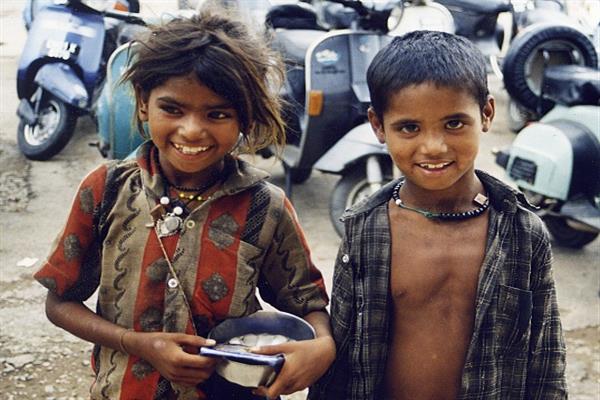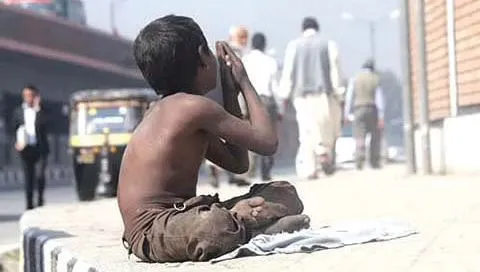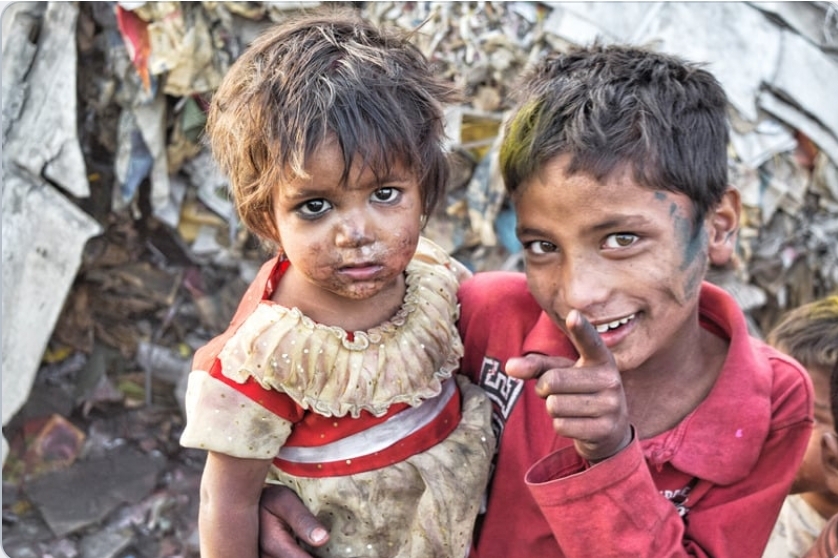In a bid to curb child begging in Kashmir, the Child Welfare Committee (CWC) undertook a series of surprise raids. The raids, initiated after an increasing number of complaints, emphasized the urgent need for comprehensive measures to address this critical issue.
By Tauheed Ahmad
In a continuous endeavor to curb the persistent issue of child begging in Kashmir, the Child Welfare Committee (CWC) of the district launched a series of surprise raids. These operations have resulted in the rescue of a total of 43 minors over a period of three months, emphasizing the need for comprehensive measures to tackle this issue.
The initiative began with a “surprise raid” in the heart of Srinagar’s Lal Chowk, where 14 child beggars, including four girls, were promptly rescued. Dr. Khair-un-Nisa, the head of CWC in Srinagar, informed. “We had been receiving complaints about frequent child begging in various parts of the Srinagar region. We decided to conduct a surprise check at Lal Chowk where we caught hold of 14 child beggars, including four girls”, she said.

What complicates this issue is the disturbing nexus between parents and their children. Dr. Nisa noted, “Their parents started begging for the release of their kids. This is what makes our job tough. There is a nexus between parents and kids. Ironically, the parents of the kids rescued were also beggars.” Nevertheless, the CWC is committed to addressing these concerns. Dr. Nisa affirmed, “We have done counseling for all the kids (all of them minors) and handed them over to the CWCs of their respective districts or states.”
The Three Categories of Child Beggars
Divulging details on the categories of child beggars, Dr. Nisa informed that local children who beg on the streets are often living alongside their parents or guardians. Their local roots and traceable whereabouts make their rehabilitation a more manageable endeavor. The committee strives to enroll them in nearby schools or reunite them with their families.
The second category comprises local children living in slums or tents. They venture onto the streets during the day to beg, returning to their living quarters after sunset. Their circumstances require more nuanced rehabilitation efforts, often involving temporary housing and educational enrollment, she informed.
The third category comprises non-local children, mostly seasonal beggars who move from one state to another on a rotational basis. These transient children pose a unique challenge due to their mobility and unfamiliarity with the local systems, she added.
Challenges Faced
Talking on the complexities while rescuing the non-local children particularly those accompanied by their parents, Dr. Nisa said that many parents are uncooperative during rescue efforts, citing potential relocations as a reason for their hesitance. This complicates the rehabilitation process, necessitating coordination with the respective state or district child welfare committees to ensure these children find their way to appropriate programs and support, she added.

Despite the committee’s relentless efforts to achieve cooperation from non-local parents it always remains an ongoing hurdle, she added. “The reluctance of parents to part with their children often hinges on the belief that they may relocate shortly, making long-term support impractical”, she said.
In such cases Dr. Nisa explained, “The committee assesses the health and financial conditions of parents, advocating for the children’s well-being and education by connecting them to government schemes, scholarships, and lodging facilities. However, this remains a frustrating challenge, as some parents still resist cooperation.”
These children are now being connected with skill development programs run by registered NGOs, offering them new opportunities for personal and educational growth.
As the Child Welfare Committee continues its efforts to combat child begging in Srinagar, growing challenges on Kashmir’s roads have caught the attention of concerned commuters. Bilal Ahmad, a daily commuter, expressed his concerns about the escalating problem of child begging at traffic junctions. According to Ahmad, this issue not only causes inconvenience but also poses significant safety hazards. He states, “Child beggars at the traffic junctions have become a daily nuisance. They knock on our car windows, causing inconvenience and safety risks.”
Rehabilitation Efforts
“Local children are more readily rehabilitated through a program known as Mission Vatsalya (Mission Vatsalya, launched by the Ministry of Women and Child Development, ensures children’s safety and security in India.),” Dr. Nisa stated. “This initiative links them with government schemes designed to support their education and access to social welfare department programs. The committee temporarily houses these children in rehabilitation centers to assess their needs, subsequently reuniting them with their families with the assurance of no forced begging”, she said.
Reflecting on recent rescue operations, she said that recent rescue operations have seen 25 children rescued from the streets. “Fortunately, there have been no signs of drug abuse, a testament to the committee’s commitment to the health and well-being of these children. Health assessments and referrals to drug de-addiction centers are standard procedures”, she said.
Prioritizing rehabilitation with a vision, Dr. Nisa underscores that, although the committee’s primary focus is rehabilitation, they increasingly recognize the imperative to investigate the root causes of child begging and exploitation. Identifying those responsible for bringing non-local children for begging is deemed crucial, and the committee is actively working towards this objective.

Dr. Nisa continued, in a recent drive it was discovered that a significant number of non-local child beggars, along with their parents or in some cases, entire villagers, have been found arriving in Kashmir. This underscores the urgent necessity for a comprehensive investigation to trace the sources behind their movement and the facilitators involved in bringing them here.
Empowering reluctant children, Dr. Nisa underscores that the committee has expanded its efforts to empower children who were previously engaged in begging and are currently unwilling to return to school. These children are now being connected with skill development programs run by registered NGOs, offering them new opportunities for personal and educational growth.
In light of the escalating concerns, Rehmatullah from Arizal Budgam sheds light on a disturbing aspect: It’s not just child begging; some fraudsters are exploiting commoners in the name of orphan support, even reaching out to farmers in their fields for ‘donations’ of their hard-earned produce. No one is taking cognizance of this growing problem.
Collaboration with Government Departments
Dr. Nisa confirms that the Child Welfare Committee collaborates with various government departments, including social welfare and the police, in their shared mission to combat child exploitation. As part of their comprehensive efforts, they provide rehabilitated children with residential facilities, nutritional support, access to education, and essential items.
She also drew attention to unregistered orphanage schools in the Kashmir region that receive donations primarily for personal gain rather than benefiting the children. “Recent actions have been taken against unregistered homes following public complaints”, she said.
Public Cooperation and Reporting Mechanisms
Dr. Nisa emphasizes the public’s increasing awareness and willingness to report instances of child exploitation through social media and other communication channels. Their active cooperation and reporting of hotspots play a crucial role in addressing this issue effectively.
Facilitating reporting and media collaboration, Dr. Nisa highlights the committee’s provision of an accessible reporting mechanism through social media handles and phone numbers, encouraging the public to share their concerns. Collaboration with the media has played a pivotal role in raising awareness about the committee’s work and significantly contributing to the success of their operations.
Involving the Community
Dr. Nisa emphasizes the committee’s call to the public, urging them to report any suspicious groups or individuals collecting donations in the name of children without proper registration. This underscores the critical importance of safeguarding children’s rights.
Additionally, the committee recognizes the necessity of involving community members and religious clerics in addressing the issue of child exploitation, highlighting the significance of securing the rights of these vulnerable children, she said.
Police Involvement
While the Municipal Corporation and Police handle the child rescue process, the Child Welfare Committee is responsible for the rehabilitation of rescued children. Dr. Khair un Nisa praises the commendable efforts of the police in rescue operations.

To address concerns about police involvement potentially scaring the children, Dr. Nisa clarified that the police’s presence is for their protection and to maintain law and order during the rescue operations.
Initial fear is a common emotion among rescued children due to their limited exposure to activities beyond begging. However, with counseling and support, these children gradually become comfortable in their new environment, sharing their stories and embracing a brighter future, she informed.
Protecting Sacred Spaces
Dr. Nisa encourages the public to actively participate in combating child labor and child begging by reporting any such incidents. The CWC can be easily reached through their office in Bemina, Srinagar, various social media platforms, or the toll-free number 1098.
Adding to the growing concerns, a devotee at a Dashtgeer Sahib shrine said that the disruption caused by child beggars at religious places is disheartening for many. Our sacred places should be for worship, not child begging. It’s disheartening to see them during religious gatherings.
Raising Awareness
Dr. Khair un Nisa emphasizes the importance of addressing the issue, particularly during the vulnerable stage of a child’s life. “This stage of a child is the golden age and needs to be optimized for schooling and building a career.”
The ongoing efforts of the Child Welfare Committee and the increasing public awareness serve as important steps in the battle against child begging and exploitation in Kashmir. With the continued cooperation of the community and relevant government departments, the hope is to provide these vulnerable children with a brighter future.
Leave a Reply